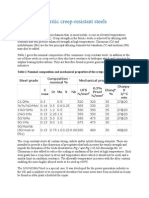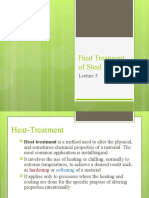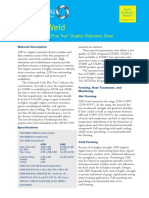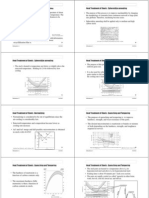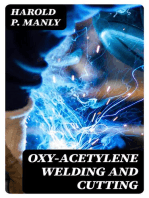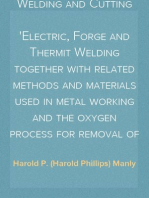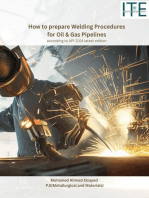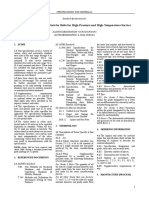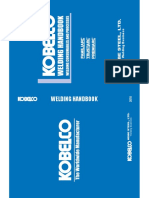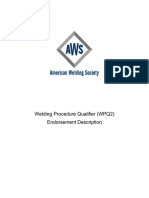Cswip - Section 20-Heat Treatment
Cswip - Section 20-Heat Treatment
Uploaded by
Nsidibe Michael EtimCopyright:
Available Formats
Cswip - Section 20-Heat Treatment
Cswip - Section 20-Heat Treatment
Uploaded by
Nsidibe Michael EtimOriginal Description:
Original Title
Copyright
Available Formats
Share this document
Did you find this document useful?
Is this content inappropriate?
Copyright:
Available Formats
Cswip - Section 20-Heat Treatment
Cswip - Section 20-Heat Treatment
Uploaded by
Nsidibe Michael EtimCopyright:
Available Formats
Section 20
Heat Treatment
Rev 2 April 2013
Heat Treatment
Copyright TWI Ltd 2013
20
Heat Treatment
20.1
Introduction
The heat treatment given to a particular grade of steel by the steelmaker/
supplier should be shown on the material test certificate and may be
referred to as the supply condition.
Welding inspectors may need to refer to material test certificates so must be
familiar with the terminology used and have some understanding of the
principles of some of the most commonly applied heat treatments.
Welded joints may need to be subjected to heat treatment after welding
(PWHT) and the tasks of monitoring the thermal cycle and checking the heat
treatment records are often delegated to welding inspectors.
20.2
Heat treatment of steel
The main supply conditions for weldable steels are:
As-rolled, hot roller and hot finished
Plate is hot rolled to finished size and allowed to air cool; the temperature at
which rolling finishes may differ from plate to plate and so strength and
toughness properties vary and are not optimised.
Applied to
Relatively thin, lower strength C-steel.
Thermomechanical controlled processing (TMCP), control-rolled,
thermomechanically rolled
Steel plate given precisely controlled thickness reductions during hot rolling
within carefully controlled temperature ranges; final rolling temperature is
also carefully controlled.
Applied to
Relatively thin, high strength low alloy (HSLA) steels and some steels with
good toughness at low temperatures, eg cryogenic steels.
Normalised
After working (rolling or forging) the steel to size, it is heated to ~900C then
allowed to cool in air to ambient temperature; which optimises strength and
toughness and gives uniform properties from item to item for a particular
grade of steel (Figure 20.1).
Applied to
C-Mn steels and some low alloy steels.
20-1
www.twitraining.com
Rev 2 April 2013
Heat Treatment
Copyright TWI Ltd 2013
Normalising:
Temperature, C
Rapid heating to soak temperature (100% austenite)
Short soak time at temperature
Cool in air to ambient temperature
~ 900C
Time
Figure 20.1 Typical normalising heat treatment applied to C-Mn and some low
alloy steels.
Quenched and tempered
After working the steel (rolling or forging) to size it is heated to ~900C then
cooled as quickly as possible by quenching in water or oil. After quenching,
the steel must be tempered (softened) to improve the ductility of the asquenched steel (Figure 20.2).
Applied to
Some low alloy steels to give higher strength toughness or wear resistance.
Temperature, C
Quenching and tempering:
~ 900C
Rapid heating to soak temperature (100% austenite).
Short soak time at temperature.
Rapid cooling by quenching in water or oil.
Reheat to tempering temperature, soak and air cool.
Quenching
cycle
Tempering
cycle
Time
Figure 20.2 A typical quenching and tempering heat treatment applied to some low
alloy steels.
20-2
www.twitraining.com
Rev 2 April 2013
Heat Treatment
Copyright TWI Ltd 2013
Solution annealed
Hot or cold working to size, steel heated to ~1100C after.
Slab heating temperature > ~ 1050C
Rolling period
Austenite
()
Temperature, C.
~ 900C
Austenite + ferrite
(
Ferrite + pearlite
() iron carbide
As-rolled or
hot rolled
Control-rolled
Or TMCP
Time
Figure 20.3 Comparison of the control-rolled (TMCP) and as-rolled (hot rolling)
conditions.
Solution heat treated
Rapidly cooled by quenching in water to prevent any carbides or other
phases forming (Figure 20.4).
Solution heat treatment:
Temperature, C
Rapid heating to soak temperature (100% austenite).
Short soak time at temperature.
Rapid cool cooling by quenching in water or oil.
> ~ 1050C
Quenching
Time
Figure 20.4 Typical solution heat treatment (solution annealing) applied to
austenitic stainless steels.
20-3
www.twitraining.com
Rev 2 April 2013
Heat Treatment
Copyright TWI Ltd 2013
Applied to
Austenitic stainless steels such as 304 and 316 grades.
Annealed
After working the steel (pressing or forging, etc) to size, it is heated to
~900C then allowed to cool in the furnace to ambient temperature; this
reduces strength and toughness but improves ductility (Figure 20.5).
Annealing:
Temperature, C
Rapid heating to soak temperature (100% austenite).
Short soak time at temperature.
Slow cool in furnace to ambient temperature.
~ 900C
Time
Figure 20.5 Typical annealing heat treatment applied to C-Mn and some low alloy
steels.
Applied to
C-Mn steels and some low alloy steels.
Figures 20.1-20.5 show thermal cycles for the main supply conditions and
subsequent heat treatment that can be applied to steels.
20.3
Postweld heat treatment (PWHT)
Postweld heat treatment has to be applied to some welded steels to ensure
that the properties of the weldment is suitable for the intended applications.
The temperature at which PWHT is usually carried out well below the
temperature where phase changes can occur (see Note), but high enough
to allow residual stresses to be relieved quickly and to soften (temper) any
hard regions in the HAZ.
Note There are circumstances when a welded joint may need to be
normalised to restore HAZ toughness, these are relatively rare and it is
necessary to ensure that welding consumables are carefully selected
because normalising will significantly reduce weld metal strength.
20-4
www.twitraining.com
Rev 2 April 2013
Heat Treatment
Copyright TWI Ltd 2013
The major benefits of reducing residual stress and ensuring that the HAZ
hardness is not too high for steels for particular service applications are:
Improves the resistance of the joint to brittle fracture.
Improves the resistance of the joint to stress corrosion cracking.
Enables welded joints to be machined to accurate dimensional
tolerances.
Because the main reason for and benefit of PWHT is to reduce residual
stresses, PWHT is often called stress-relief.
20.4
PWHT thermal cycle
The Application Standard/Code will specify when PWHT is required to give
the first two benefits above and also give guidance about the thermal cycle
that must be used.
To ensure that a PWHT cycle is carried out in accordance with a particular
Code, it is essential that a PWHT procedure is prepared and the following
parameters are specified:
20.4.1
Maximum heating rate.
Soak temperature range.
Minimum time at the soak temperature (soak time).
Maximum cooling rate.
Heating rate
Must be controlled to avoid large temperature differences, (large thermal
gradients) within the fabricated item. Which will produce large stresses and
may be high enough to cause distortion or even cracking.
Application Standards usually require control of the maximum heating rate
when the temperature of the item is above ~300C because steels start to
show significant loss of strength above this temperature and are more
susceptible to distortion if there are large thermal gradients.
The temperature of the fabricated item must be monitored during the
thermal cycle by thermocouples attached to the surface at locations
representing the thickness range of the item.
By monitoring furnace and item temperatures the rate of heating can be
controlled to ensure compliance with Code requirements at all positions
within the item.
Maximum heating rates specified for C-Mn steel depend on the thickness of
the item but tend to be in the range ~60 to ~200C/h.
20-5
www.twitraining.com
Rev 2 April 2013
Heat Treatment
Copyright TWI Ltd 2013
20.4.2 Soak temperature
The soak temperature specified by the Code depends on the type of steel
and thus the temperature range required reducing residual stresses to a low
level.
C and C-Mn steels require a soak temperature of ~600C whereas some
low alloy steels (such as Cr-Mo steels used for elevated temperature
service) require higher temperatures, typically in the range ~700-~760C.
Soak temperature is an essential variable for a WPQR, so it is very
important it is controlled within the specified limits otherwise it may be
necessary to carry out a new WPQ test to validate the properties of the item
and at worst it may not be fit-for-purpose.
20.4.3 Soak time
It is necessary to allow time for all the welded joints to experience the
specified temperature throughout the full joint thickness.
The temperature is monitored by surface contact thermocouples and it is
the thickest joint of the fabrication that governs the minimum time for
temperature equalisation.
Typical specified soak times are 1h per 25mm thickness.
20.4.4
Cooling rate
It is necessary to control the rate of cooling from the PWHT temperature for
the same reason that heating rate needs to be controlled, to avoid distortion
or cracking due to high stresses from thermal gradients.
Codes usually specify controlled cooling to ~300C. Below this temperature
the item can be withdrawn from a furnace and allowed to cool in air because
steel is relatively strong and unlikely to suffer plastic strain by any
temperature gradients that may develop.
20-6
www.twitraining.com
Rev 2 April 2013
Heat Treatment
Copyright TWI Ltd 2013
PWHT (C-Mn steels):
Temperature,C
Controlled heating rate from 300C to soak temperature.
Minimum soak time at temperature.
Controlled cooling to ~ 300C.
~ 600C
Controlled heating
and cooling rates
~300C
Soak
time
Air cool
Time
Figure 20.6 Typical PWHT applied to C-Mn steels.
20.5
Heat treatment furnaces
Oil- and gas-fired furnaces used for PWHT must not allow flame contact
with the fabrication as this may induce large thermal gradients.
It is also important to ensure that the fuel particularly for oil-fired furnaces
does not contain high levels of potentially harmful impurities, such as
sulphur.
20.5.1 Local PWHT
For a pipeline or pipe spool it is often necessary to apply PWHT to individual
welds by local application of heat.
For this, a PWHT procedure must specify the previously described
parameters for controlling the thermal cycle but it is also necessary to
specify the following:
Width of the heated band (must be within the soak temperature range).
Width of the temperature decay band (soak temperature to ~300C).
Other considerations are:
Position of the thermocouples in the heated band width and the decay
band.
If the item needs support in a particular way to allow movement/
avoid distortion.
The commonest method of heating for local PWHT is by insulated electrical
elements (electrical mats) attached to the weld.
20-7
www.twitraining.com
Rev 2 April 2013
Heat Treatment
Copyright TWI Ltd 2013
Gas-fired, radiant heating elements can also be used.
Figure 20.7 shows typical control zones for localised PWHT of a pipe butt
weld.
Weld seam
temp.
decay
band
heated band
temp.
decay
band
Figure 20.7 Local PWHT of a pipe girth seam.
20-8
www.twitraining.com
You might also like
- API 614-Gen. PurposeDocument20 pagesAPI 614-Gen. Purposemishraengg100% (2)
- Heat Treatment of Welded JointsDocument11 pagesHeat Treatment of Welded JointsMuhammed SulfeekNo ratings yet
- Brennan 2002Document8 pagesBrennan 2002Karla HernándezNo ratings yet
- As Rolled, Hot Rolled, Hot Finished: Applied ToDocument8 pagesAs Rolled, Hot Rolled, Hot Finished: Applied ToAlaaNo ratings yet
- Heat Treatment of Welded JointsDocument3 pagesHeat Treatment of Welded JointsJlkKumarNo ratings yet
- Post Weld Heat TreatmentDocument2 pagesPost Weld Heat TreatmentgullenariNo ratings yet
- HT ManualDocument17 pagesHT ManualAkhilesh KumarNo ratings yet
- Heat Treatment of SteelsDocument9 pagesHeat Treatment of SteelsEhsan KhanNo ratings yet
- 02 Hilkes Gross Welding of CrMo Steels For Power Generation and Petrochemical ApplicationsDocument12 pages02 Hilkes Gross Welding of CrMo Steels For Power Generation and Petrochemical Applicationsivanmatijevic100% (1)
- Highlight WeldCanada CSA AWS Guides Preheat PWHTDocument5 pagesHighlight WeldCanada CSA AWS Guides Preheat PWHTAnonymous rYZyQQot55No ratings yet
- Balancing Wear, StrengthDocument4 pagesBalancing Wear, StrengthStephen MontelepreNo ratings yet
- Welding of Ferritic CreepDocument3 pagesWelding of Ferritic CreepMuhammed SulfeekNo ratings yet
- Postweld Heat Treatment: The Need For Post Heating Assumes A Potential Hydrogen Cracking Problem Exists..Document7 pagesPostweld Heat Treatment: The Need For Post Heating Assumes A Potential Hydrogen Cracking Problem Exists..diegobecerraNo ratings yet
- Post WeldDocument4 pagesPost WelddanemsalNo ratings yet
- Heat Treatment of SteelDocument59 pagesHeat Treatment of SteelNaman ShethNo ratings yet
- PWHT, HT, Igc, MawpDocument40 pagesPWHT, HT, Igc, Mawpsachinshirnath100% (1)
- Engg Metallurgy Lecture 5Document54 pagesEngg Metallurgy Lecture 5Patil Sudheer GowdNo ratings yet
- Through Hardening ProcessesDocument3 pagesThrough Hardening ProcessesPurushothama Nanje Gowda100% (3)
- Stress RelievingDocument3 pagesStress RelievingAbhishek NagNo ratings yet
- Welding of HSLA Steels: Weldability and Joining of MaterialsDocument2 pagesWelding of HSLA Steels: Weldability and Joining of MaterialsMehmet SoysalNo ratings yet
- Heat Treatment of Welded JointsDocument26 pagesHeat Treatment of Welded Jointslinhcdt3No ratings yet
- Post Weld Heat TreatmentDocument10 pagesPost Weld Heat Treatmentcristian291011No ratings yet
- Heat Treatment of Welded JointsDocument4 pagesHeat Treatment of Welded JointskingstonNo ratings yet
- Heat Treatment of Welded JointsDocument17 pagesHeat Treatment of Welded JointsErick HoganNo ratings yet
- Concept of Post Weld Heat Treatment PDFDocument2 pagesConcept of Post Weld Heat Treatment PDFsridharchebrolu100% (2)
- What Is PWHTDocument15 pagesWhat Is PWHTsanthoshm123098No ratings yet
- M 1.2.7 Heat Treatment of Base Materials and Welded JointDocument10 pagesM 1.2.7 Heat Treatment of Base Materials and Welded Jointdokumen qcNo ratings yet
- Artilce - Potential Detrimental Consequences of Excessive PWHT On Steel PropertiesDocument8 pagesArtilce - Potential Detrimental Consequences of Excessive PWHT On Steel PropertieswholenumberNo ratings yet
- Heat Treatment of SteelsDocument6 pagesHeat Treatment of SteelsSrinivas LaishettyNo ratings yet
- Process Specification For The Heat Treatment of Steel AlloysDocument12 pagesProcess Specification For The Heat Treatment of Steel AlloystetirichieNo ratings yet
- Welding Heat TreatmentDocument33 pagesWelding Heat TreatmentWan HafiyNo ratings yet
- GN06 Post Weld Heat Treatment of Welded PDFDocument11 pagesGN06 Post Weld Heat Treatment of Welded PDFGregory Fenwick100% (1)
- Datasheet How To Weld 2205 Hpsa Imperial Outokumpu en AmericasDocument7 pagesDatasheet How To Weld 2205 Hpsa Imperial Outokumpu en AmericasJavier Alejandro Rodriguez MelgozaNo ratings yet
- 3 Eng Stainless Steel Tube AnnealingDocument16 pages3 Eng Stainless Steel Tube AnnealingVictor HugoNo ratings yet
- Heat TreamentDocument9 pagesHeat TreamentAtul GaurNo ratings yet
- Heat Treatment of SS Clad CS After Fiber ElongationDocument3 pagesHeat Treatment of SS Clad CS After Fiber ElongationarifhonNo ratings yet
- 8-16 Metallurgy For Heat TreatmentDocument9 pages8-16 Metallurgy For Heat TreatmentvishalNo ratings yet
- Heat Treatment GC - 08Document54 pagesHeat Treatment GC - 08kr_abhijeet72356587No ratings yet
- Uddeholm Heat Treatment of Tool Steel 06.2012 E8Document20 pagesUddeholm Heat Treatment of Tool Steel 06.2012 E8tecnico0104No ratings yet
- Heat TreatmentDocument59 pagesHeat TreatmentINSTECH Consulting100% (1)
- Normalization and Temper Heat Treatment On P91Document6 pagesNormalization and Temper Heat Treatment On P91Asad Bin Ala Qatari100% (2)
- Heat TreatmentDocument20 pagesHeat Treatmentعزت عبد المنعمNo ratings yet
- Heat TreatmentDocument14 pagesHeat TreatmentAkhilesh KumarNo ratings yet
- 4 Eng Induction Welded Small Diameter TubeDocument22 pages4 Eng Induction Welded Small Diameter TubeDimitri PanagiotouNo ratings yet
- B849 Galvanizado ENVIAR PDFDocument3 pagesB849 Galvanizado ENVIAR PDFBraulio Carvajal100% (1)
- PWHTDocument2 pagesPWHTvsajuNo ratings yet
- Pengembangan Energy Consumption To Forging and CastingDocument20 pagesPengembangan Energy Consumption To Forging and CastingRefky FNo ratings yet
- Heat TreatmentDocument70 pagesHeat TreatmentAbdulmhsen ALjreedan100% (1)
- Chapter 4 Heat Treatment of SteelDocument29 pagesChapter 4 Heat Treatment of SteelDa Champ Cena100% (2)
- Heat TreatingDocument8 pagesHeat Treatingbehi64No ratings yet
- Heat Treatment: Unit - IiDocument94 pagesHeat Treatment: Unit - Iisenthilkumar tsNo ratings yet
- Welding BasicsDocument8 pagesWelding BasicsRajimmanuelNo ratings yet
- Repair Welding Temper BeadDocument9 pagesRepair Welding Temper BeadwilliamjdtNo ratings yet
- Oxy-Acetylene Welding and Cutting: Electric, Forge and Thermit Welding together with related methods and materials used in metal working and the oxygen process for removal of carbonFrom EverandOxy-Acetylene Welding and Cutting: Electric, Forge and Thermit Welding together with related methods and materials used in metal working and the oxygen process for removal of carbonNo ratings yet
- Oxy-Acetylene Welding and Cutting Electric, Forge and Thermit Welding together with related methods and materials used in metal working and the oxygen process for removal of carbonFrom EverandOxy-Acetylene Welding and Cutting Electric, Forge and Thermit Welding together with related methods and materials used in metal working and the oxygen process for removal of carbonNo ratings yet
- How to prepare Welding Procedures for Oil & Gas PipelinesFrom EverandHow to prepare Welding Procedures for Oil & Gas PipelinesRating: 5 out of 5 stars5/5 (1)
- Welding Terminology: A Guide to MIG, TIG, Stick, Gas, and Spot Welding TermsFrom EverandWelding Terminology: A Guide to MIG, TIG, Stick, Gas, and Spot Welding TermsNo ratings yet
- The Working of Steel: Annealing, Heat Treating and Hardening of Carbon and Alloy SteelFrom EverandThe Working of Steel: Annealing, Heat Treating and Hardening of Carbon and Alloy SteelNo ratings yet
- Proceedings of the 2014 Energy Materials Conference: Xi'an, Shaanxi Province, China, November 4 - 6, 2014From EverandProceedings of the 2014 Energy Materials Conference: Xi'an, Shaanxi Province, China, November 4 - 6, 2014No ratings yet
- Modulhandbuch 14-09-2022 EnglDocument52 pagesModulhandbuch 14-09-2022 EnglNsidibe Michael EtimNo ratings yet
- 3 - PCS1 Split-CHHighlights of Revisions To SSPC-CS 23.00 - AWS C223M - NACE No. 12 Specification For Thermal Spray Coatings (TSC) KTA-TatorDocument1 page3 - PCS1 Split-CHHighlights of Revisions To SSPC-CS 23.00 - AWS C223M - NACE No. 12 Specification For Thermal Spray Coatings (TSC) KTA-TatorNsidibe Michael EtimNo ratings yet
- Epoxy Coating Comparison Chart - Sherwin-Williams Protective & Marine CoatingsDocument9 pagesEpoxy Coating Comparison Chart - Sherwin-Williams Protective & Marine CoatingsNsidibe Michael EtimNo ratings yet
- Common Causes - Sherwin-Williams Protective & Marine CoatingsDocument3 pagesCommon Causes - Sherwin-Williams Protective & Marine CoatingsNsidibe Michael EtimNo ratings yet
- Questions To Pose To Customer For - American Galvanizers AssociationDocument3 pagesQuestions To Pose To Customer For - American Galvanizers AssociationNsidibe Michael EtimNo ratings yet
- Passivation - American Galvanizers AssociationDocument1 pagePassivation - American Galvanizers AssociationNsidibe Michael EtimNo ratings yet
- Customer Complaints About Wet Storage Stain - American Galvanizers AssociationDocument3 pagesCustomer Complaints About Wet Storage Stain - American Galvanizers AssociationNsidibe Michael EtimNo ratings yet
- Thermax Limited: Inspection Procedure For GalvanizingDocument14 pagesThermax Limited: Inspection Procedure For GalvanizingNsidibe Michael EtimNo ratings yet
- Appendix A & CDocument7 pagesAppendix A & CAmr HeshamNo ratings yet
- Manoj MDocument36 pagesManoj Mmanojm12062002No ratings yet
- Nickel Base AlloysDocument2 pagesNickel Base AlloysElMacheteDelHuesoNo ratings yet
- SAE/AISI Carbon Steel Naming Conventions: Topics CoveredDocument4 pagesSAE/AISI Carbon Steel Naming Conventions: Topics CoveredSonia Maria ZapataNo ratings yet
- IPS E-ME-130 LPG Pressure Storage Spheres 22p Rev. 2011Document24 pagesIPS E-ME-130 LPG Pressure Storage Spheres 22p Rev. 2011josea_penaNo ratings yet
- Iso 11120-2015Document40 pagesIso 11120-2015MaciekNo ratings yet
- Steel Ball Skew Rolling Machine IntroductionDocument9 pagesSteel Ball Skew Rolling Machine IntroductionSilvia Sianipar silviasianipar.2019No ratings yet
- Ceramic Fiber Module Insulation For FurnacesDocument5 pagesCeramic Fiber Module Insulation For FurnacesAleem QureshiNo ratings yet
- MR 315Document2 pagesMR 315David SMNo ratings yet
- Western Valve Double Block and Bleed Valve (DBB Valve) Dual Expanding Plug ValveDocument5 pagesWestern Valve Double Block and Bleed Valve (DBB Valve) Dual Expanding Plug ValveEdisson SanabriaNo ratings yet
- T.T.I. - Tubacex Tubos Inoxidables, S.A.: Mill Test CertificateDocument3 pagesT.T.I. - Tubacex Tubos Inoxidables, S.A.: Mill Test CertificateMANUFACTURER OF FORGED FLANGES AND PIPE FITTINGSNo ratings yet
- Quality Assurance Plan: Sheet MetalDocument2 pagesQuality Assurance Plan: Sheet Metalsabir hussainNo ratings yet
- Thermal Stability and Anti-Corrosion Analysis of Alloy Coatings On Overhead Ground WiresDocument7 pagesThermal Stability and Anti-Corrosion Analysis of Alloy Coatings On Overhead Ground WiresKedar BhaveNo ratings yet
- To Edit Per QualificationDocument180 pagesTo Edit Per QualificationMarwin NavarreteNo ratings yet
- Astm F 568MDocument9 pagesAstm F 568MZahoor Ahmed Mohsan100% (1)
- Static Equipment A Look Inside The How and Why of Specification - Part5Document2 pagesStatic Equipment A Look Inside The How and Why of Specification - Part5BergheisenNo ratings yet
- Carbon and Alloy Steel Nuts For Bolts For High-Pressure and High-Temperature ServiceDocument8 pagesCarbon and Alloy Steel Nuts For Bolts For High-Pressure and High-Temperature ServiceKaterin HernandezNo ratings yet
- Uniclass 2015 April 2020 UpdateDocument48 pagesUniclass 2015 April 2020 Updateabdullah sahibNo ratings yet
- 701 Armox - Welding RecommendationsDocument5 pages701 Armox - Welding RecommendationsSergio MuñozNo ratings yet
- Welding Qualification: by L D PoyyaraDocument45 pagesWelding Qualification: by L D PoyyaraAshish GhadiyaNo ratings yet
- Brittle Fracture of Carbon Steel Piping During Hydrostatic TestingDocument4 pagesBrittle Fracture of Carbon Steel Piping During Hydrostatic TestingSH1961No ratings yet
- Armstrong S & H Pump BrochureDocument8 pagesArmstrong S & H Pump BrochureAhmed SamirNo ratings yet
- DEMO-ASME Filler Metals DatabaseDocument6 pagesDEMO-ASME Filler Metals DatabaseadammzjinNo ratings yet
- MDDocument17 pagesMDJay ShindeNo ratings yet
- Kobel CoDocument2 pagesKobel Cohailay83No ratings yet
- WPQ2 Program DescriptionDocument5 pagesWPQ2 Program DescriptionCraigNo ratings yet
- Tool SteelsDocument6 pagesTool Steelskbwoniu123No ratings yet
- Evaluating Coatings For High Temperature Service: Standard Test Methods ForDocument3 pagesEvaluating Coatings For High Temperature Service: Standard Test Methods ForFernando Berrospi Garay100% (1)












